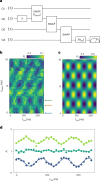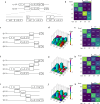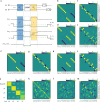Universal control of four singlet-triplet qubits
- PMID: 39482413
- PMCID: PMC11835736
- DOI: 10.1038/s41565-024-01817-9
Universal control of four singlet-triplet qubits
Abstract
The coherent control of interacting spins in semiconductor quantum dots is of strong interest for quantum information processing and for studying quantum magnetism from the bottom up. Here we present a 2 × 4 germanium quantum dot array with full and controllable interactions between nearest-neighbour spins. As a demonstration of the level of control, we define four singlet-triplet qubits in this system and show two-axis single-qubit control of each qubit and SWAP-style two-qubit gates between all neighbouring qubit pairs, yielding average single-qubit gate fidelities of 99.49(8)-99.84(1)% and Bell state fidelities of 73(1)-90(1)%. Combining these operations, we experimentally implement a circuit designed to generate and distribute entanglement across the array. A remote Bell state with a fidelity of 75(2)% and concurrence of 22(4)% is achieved. These results highlight the potential of singlet-triplet qubits as a competing platform for quantum computing and indicate that scaling up the control of quantum dot spins in extended bilinear arrays can be feasible.
© 2024. The Author(s).
Conflict of interest statement
Competing interests: The authors declare no competing interests.
Figures













References
-
- Vandersypen, L. et al. Interfacing spin qubits in quantum dots and donors—hot, dense, and coherent. npj Quantum Inf.3, 34 (2017).
-
- Heinrich, A. J. et al. Quantum-coherent nanoscience. Nat. Nanotechnol.16, 1318–1329 (2021). - PubMed
-
- Gonzalez-Zalba, M. et al. Scaling silicon-based quantum computing using CMOS technology. Nat. Electron.4, 872–884 (2021).
-
- Chatterjee, A. et al. Semiconductor qubits in practice. Nat. Rev. Phys.3, 157–177 (2021).
-
- Stano, P. & Loss, D. Review of performance metrics of spin qubits in gated semiconducting nanostructures. Nat. Rev. Phys.4, 672–688 (2022).
Grants and funding
- 882848/EC | EU Framework Programme for Research and Innovation H2020 | H2020 Priority Excellent Science | H2020 European Research Council (H2020 Excellent Science - European Research Council)
- VI.Veni.212.223./Nederlandse Organisatie voor Wetenschappelijk Onderzoek (Netherlands Organisation for Scientific Research)
LinkOut - more resources
Full Text Sources
Research Materials

